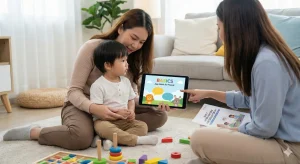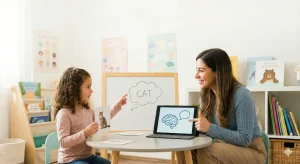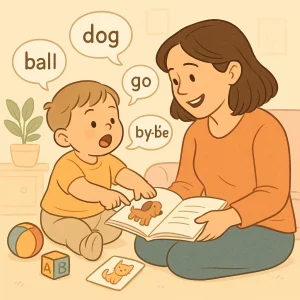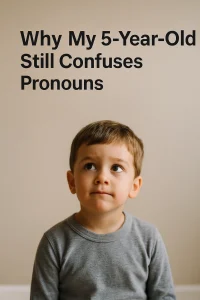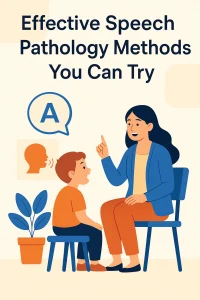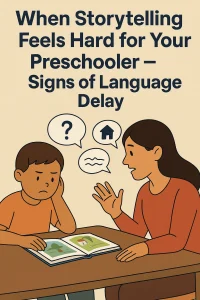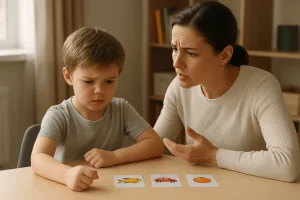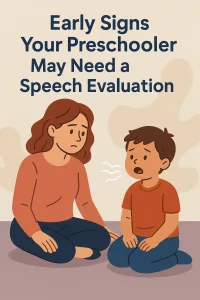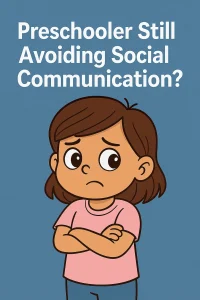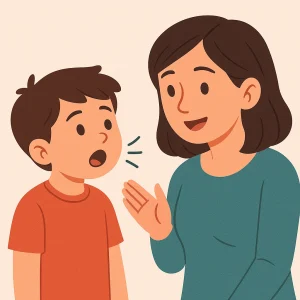Echolalia in Autism: Practical Strategies for Language Growth
By Rajini D
Last Updated: November 7, 2024
If you’re a parent or caregiver of a child with autism, you might have noticed your child repeating words, phrases, or even entire sentences they’ve heard from others. This behavior, known as echolalia, is common in children on the autism spectrum. Echolalia can appear in many forms—from immediately repeating something they hear to recalling and saying a phrase hours or even days later.
But why does echolalia happen, and what role does it play in language development? For many children with autism, echolalia serves as an early step toward communication. While it may seem repetitive, it’s often a way for children to process language, express themselves, or even self-soothe when they’re feeling overwhelmed.
Definition of Echolalia
Echolalia is the repetition of words, phrases, or sentences that a child has heard, often from others around them or from media like television or songs. For example, a child might hear the phrase “It’s time to go!” and repeat it immediately after hearing it or later in a different situation. It’s a form of language imitation and is very common in children with Autism Spectrum Disorder (ASD).
Think of echolalia as a first step in communication. While it may seem repetitive or out of context to those around them, for children with autism, repeating phrases is often a way of connecting with language and learning how words sound and work together.
Definition and Understanding the Basics
Why Echolalia Occurs in Autism
Echolalia can happen for various reasons in children with autism, and understanding these can help parents and caregivers respond in ways that support language growth. Here are some common reasons why echolalia occurs:
- Processing Language: For many children on the autism spectrum, language doesn’t always come easily or naturally. Repeating words or phrases helps them process what they’ve heard. Through repetition, they can make sense of language patterns and learn how words connect.
- Expressing Needs or Emotions: Sometimes, children use echolalia to express their feelings or communicate something they need. If a child has heard the phrase “I’m hungry” and repeats it when they want to eat, they’re using echolalia to convey their needs. This can be an important form of self-expression before they’re able to create new sentences independently.
- Finding Comfort or Self-Soothing: Language repetition can be calming for some children, especially when they’re feeling anxious or overstimulated. The familiar words or phrases provide a sense of predictability and comfort, making it easier to cope in overwhelming situations.
Types of Echolalia
Echolalia can show up in two main forms: immediate and delayed. Each type has its own unique role in a child’s communication and is often used by children with autism to process language, connect with others, or simply find comfort in familiar words.
Immediate Echolalia
Immediate echolalia is when a child repeats a word, phrase, or sentence right after they hear it. Imagine you say to a child, “It’s snack time!” and they immediately respond with, “It’s snack time!” This type of echolalia happens instantly, without any delay.
For children with autism, immediate echolalia can be a way to:
- Acknowledge or process what’s been said: Repeating a phrase right away may help them understand or internalize it.
- Participate in a conversation: While they might not yet have the words to respond uniquely, repeating can feel like a way of engaging with others.
- Express excitement or curiosity: Sometimes, repeating an exciting or interesting phrase is a way to show enthusiasm or interest.
Example: If you ask, “Do you want to go outside?” and the child responds, “Do you want to go outside?” it could mean they’re processing the question or trying to connect with you.
Delayed Echolalia
Delayed echolalia happens when a child repeats a word, phrase, or sentence long after hearing it—sometimes hours, days, or even weeks later. This often involves phrases from TV shows, songs, or past conversations.
For instance, a child might repeatedly quote their favorite line from a cartoon they watched last week or recall a comforting phrase they heard from a parent, like “It’s okay, don’t worry,” when they’re feeling anxious. Delayed echolalia can be especially significant for children with autism because it allows them to recall language that feels meaningful or reassuring.
Example: If a child frequently says, “Let’s go on an adventure!” (a line from a favorite TV show) whenever they’re about to leave the house, they may be using it as a way to express excitement or a sense of routine.
Functions of Echolalia
Echolalia, whether immediate or delayed, serves several important functions for children with autism, even if they aren’t yet using their own words or sentences. Here’s how it can help:
| Function | Description |
|---|---|
| Communication | Echolalia can be a child’s way of responding, showing understanding, or expressing a need. |
| Self-Soothing | Familiar phrases can help a child feel calm and secure, especially in new or overwhelming situations. |
| Practicing Language | Repeating words and phrases helps children learn how language sounds and feels. |
| Building Connection | Using phrases they’ve heard, children can feel connected to others, even if they’re not yet using original speech. |
By understanding the types and functions of echolalia, parents and caregivers can respond in ways that support language development. Instead of viewing echolalia as mere repetition, it’s helpful to see it as a step toward communication. Each repeated phrase is an opportunity for learning, connection, and growth in your child’s language journey.
Types of Echolalia:
| Feature | Immediate Echolalia | Delayed Echolalia |
|---|---|---|
| Timing | Immediate repetition of words or phrases just heard. | Repetition of previously heard words or phrases after a delay. |
| Context | Often occurs in response to a recent stimulus or conversation. | Can happen at any time, even when not directly prompted by the current context. |
| Function | Often serves a communicative or interactive purpose in the moment. | May serve various functions, including self-soothing, expression, or processing information. |
| Speech Development | Can be part of normal language development in early childhood. | More commonly associated with neurodevelopmental disorders, such as autism spectrum disorder. |
| Awareness | May reflect immediate understanding or repetition without deep comprehension. | Can indicate a strong memory recall but may not always demonstrate full comprehension. |
| Examples | – Child hears, “Do you want juice?” and responds, “Do you want juice?” – Person with Tourette’s syndrome repeating others’ words involuntarily. | – Child watches a video, hears a line, and repeats it later, seemingly out of context. – Individual with Alzheimer’s disease repeating phrases from earlier conversations. |
The Impact of Echolalia on Language Development
Echolalia can be both a challenge and a stepping stone in a child’s language journey, especially for those with autism. While it may seem repetitive, it can play an essential role in helping children understand language and build their own communication skills.
Challenges and Benefits of Echolalia
Challenges:
Echolalia can sometimes limit spontaneous language development. Since a child may repeat words or phrases they’ve heard instead of creating their own sentences, it can delay the development of original speech. For instance, a child who frequently uses repeated phrases might find it harder to express new thoughts or respond uniquely to questions. This can create frustration for both the child and their caregivers, especially when the child is unable to convey their needs directly.
However, it’s important to remember that echolalia is a normal stage in language development for many children with autism. Rather than viewing it as a limitation, understanding it as part of a process can make it easier to support.
Benefits:
Echolalia can actually serve as a bridge to more functional language. Repeating phrases allows children to practice language structure, tone, and rhythm, which can help them gain comfort with language use over time. Think of it like a rehearsal for speaking: with each repetition, a child is learning how words sound together, how sentences flow, and how different tones convey different emotions. This foundation can lead to spontaneous language, where the child gradually moves from repetition to creating their own sentences and responses.
Echolalia can also provide opportunities to learn important language functions, like making requests, answering questions, and expressing emotions. By modeling new phrases and gently encouraging variations, caregivers can guide children toward using language in ways that feel natural to them.
Role in Social Interactions
Echolalia can impact a child’s social interactions in both positive and negative ways, depending on how it’s managed and understood.
Positive Impacts:
- Participation in Conversations: Echolalia allows children to take part in conversations, even if they’re not yet ready to create their own responses. Repeating familiar phrases can help a child feel included in social exchanges.
- Shared Enjoyment and Humor: Many children repeat phrases from their favorite shows or songs. Sharing these phrases with others can create moments of connection and enjoyment, as caregivers and friends recognize and respond to the child’s favorite lines or expressions.
- Understanding Social Cues: Through repetition, children can learn the timing and flow of conversations, which helps them understand when to speak, respond, and listen.
Negative Impacts:
- Difficulty Responding Appropriately: In some situations, echolalia may lead to responses that seem out of place or don’t fully answer a question. For example, if a child repeats “It’s snack time!” in response to “How are you feeling?” it may be challenging for others to understand their true thoughts.
- Social Frustration: When echolalia becomes the primary way a child communicates, they may struggle to express original ideas. This can sometimes lead to frustration if others don’t understand or misinterpret what the child is trying to say.
| Impact on Social Interactions | Positive Effects | Challenges |
|---|---|---|
| Participating in Conversations | Repetition lets the child join conversations. | Responses may seem out of context or repetitive. |
| Building Connection | Sharing favorite phrases can create bonding. | Others may misinterpret the child’s meaning. |
| Learning Social Cues | Repetition helps with timing in conversations. | May limit development of original responses. |
By understanding both the challenges and benefits of echolalia, caregivers and parents can view it as an important part of their child’s communication growth. Instead of discouraging echolalia, caregivers can learn to shape it into functional language, helping children move from repetition to more independent and meaningful speech.
Strategies to Support Language Development and Manage Echolalia
Helping a child move from repeating phrases to using language functionally can feel challenging, but simple, consistent strategies can make a big difference. Here are some effective ways to encourage language development and manage echolalia with ease.
Encouraging Functional Language Use
One of the most powerful strategies for supporting language growth is to gently guide children to use words for specific purposes, like asking for items, expressing their emotions, or making simple choices. When children with autism use words to meet their needs or share their feelings, they start seeing language as a tool they can use independently.
Example Strategy: If a child often repeats “juice” after hearing it, you could encourage them to use “juice” as a request by saying, “Say ‘I want juice’ when you’re thirsty.”
Reinforcing New Language Skills
Positive reinforcement can be incredibly motivating for children. When a child tries a new word or makes an effort to use language in a different way, showing appreciation can encourage them to keep using those words.
Example Strategy: Every time your child says “help” when they need assistance, reinforce it with praise or a small reward, like a favorite snack or a smile. The more positive attention they receive for using functional language, the more likely they are to repeat it.
Using Simple and Clear Speech
Children often learn by example, and when we model simple, clear language, it’s easier for them to understand and try using those words themselves. Speak slowly and use short sentences, emphasizing key words. This helps them focus on essential parts of the sentence without feeling overwhelmed.
Example Strategy: Instead of saying, “Do you want to go outside to play?” try, “Let’s go outside!” This makes it easier for the child to pick up on the key phrase.
Visual Supports and Cues
Visual supports, like pictures, flashcards, or routine charts, are invaluable tools for children who rely on echolalia. By pairing visuals with words, children gain an extra layer of understanding, which helps reduce their reliance on repeated phrases.
Example Strategy: If a child often repeats “go,” you could use a picture of a door or an outdoor scene and say, “Go outside.” Over time, the visual support helps them connect the word “go” with the action of going outside.
Therapy-Based Techniques for Reducing Echolalia
For children with autism, echolalia can be managed and gradually transformed into more useful language with targeted therapy. Here are three effective methods that help children move from repeating phrases to using independent, meaningful speech.
1. Verbal Behavior Therapy (VBT)
- What It Is: Verbal Behavior Therapy (VBT) teaches children how to use language in practical, everyday situations. It breaks down language into small, easy steps, helping children learn to use words to express their needs and thoughts.
- How It Helps: VBT is especially helpful for children who rely on echolalia, as it introduces functional words and phrases that they can use in real life.
- Example Activity: A child who often says “open door” might be taught to use the word “open” in other situations, like “open jar” or “open book.” This helps them understand the purpose of the word and apply it in different ways.
2. Applied Behavior Analysis (ABA)
- What It Is: Applied Behavior Analysis (ABA) is a common therapy for autism. It uses rewards to encourage positive behaviors, including spontaneous language use.
- How It Helps: In ABA, children are rewarded when they use their own words instead of repeating phrases. This makes it more likely they’ll try independent speech.
- Example Activity: If a child usually repeats “It’s snack time!” when asked “How are you feeling?”, ABA might encourage them to say “I’m happy” instead. Each time they use their own words, they get a reward, like a smile or small treat, to build confidence.
3. Social Scripts
- What They Are: Social scripts are simple phrases that children can use in common situations. These help children feel more comfortable in social settings and reduce echolalia.
- How They Help: Social scripts give children predictable words or sentences to say, which builds confidence. Over time, they can learn to vary their responses.
- Example Script: For introductions, a child might start with “Hi, my name is [child’s name].” Practicing this regularly helps the child feel more at ease and reduces echolalia in these situations.
Therapy Techniques for Language Development
| Therapy Technique | Purpose | Example Activity |
|---|---|---|
| Verbal Behavior Therapy | Helps children learn functional language in steps | Teaching “open” to use in different situations, like “open jar.” |
| Applied Behavior Analysis | Encourages independent speech with rewards | Prompting “I’m happy” instead of a repeated phrase with a reward |
| Social Scripts | Provides simple phrases for social situations | Practicing “Hi, my name is…” for greetings to build confidence |
Conclusion
Echolalia can be a meaningful step toward communication for children with autism. With patience, simple goals, and supportive strategies, echolalia can transform into purposeful language. Celebrate each small achievement, track progress, and remember that each child’s language journey is unique. By using tools, visual supports, and structured therapy techniques, you can make language development fun and engaging. For more guidance, explore Wellness Hub’s home therapy resources for autism support. Every word gained is a step forward—helping your child express themselves and connect with the world around them.
Frequently Asked Questions
1. What is Echolalia and How Does It Relate to Language Development?
Echolalia is the repetition of words, phrases, or sentences spoken by others, either immediately after hearing them or after a delay. It plays a significant role in language development, particularly in children, as it helps them to practice and internalize language structures, aiding in the development of grammar, syntax, semantics, and vocabulary.
2. Is Echolalia Normal in Children’s Language Development?
Yes, in typical language development, echolalia is a natural and temporary phase in early childhood. It serves as a method for children to practice and reinforce language skills, helping them understand the structure and meaning of language.
3. How Does Echolalia Manifest in Individuals with Autism Spectrum Disorder (ASD)?
In individuals with ASD, echolalia often appears in two forms: immediate echolalia (repeating what is heard immediately) and delayed echolalia (repeating phrases after a period). It may serve various functions, such as communication, self-soothing, or processing information.
4. What Are the Intervention Strategies for Echolalia?
Intervention strategies include Applied Behaviour Analysis (ABA), Speech and Language Therapy, and Social Communication Interventions. These approaches focus on improving communication skills, reducing inappropriate echolalic behaviors, and teaching alternative, more functional ways to communicate.
5. How Can Caregivers and Educators Support Individuals with Echolalia?
Support can include providing a structured environment, using visual supports, encouraging functional communication, implementing modeling, prompting and cueing for appropriate language use, and reinforcing positive communication behaviors. It’s important to tailor these approaches to the individual’s specific needs.
About the Author:
Rajini Darugupally
M.Sc., Speech-Language Pathologist (9+ years of experience)
Rajini is a passionate and dedicated Speech-Language Pathologist with over 9+ years of experience, specializing in both developmental speech and language disorders in children and rehabilitation in adults. Currently, at Wellness Hub, she thrives in a team environment that values innovation, compassion, and achieving results for their clients.
Book your Free Consultation Today
Parent/Caregiver Info:
Client’s Details:
* Error Message
